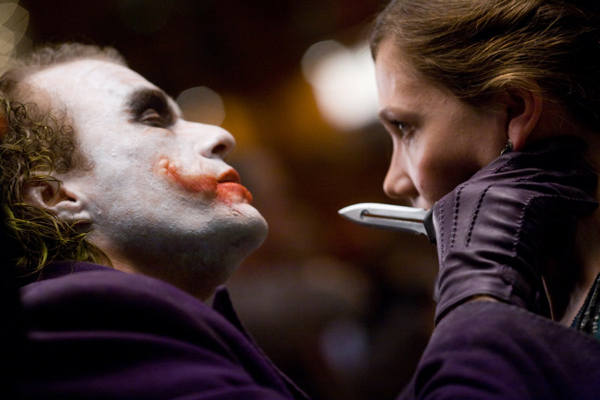Movie review by Greg Carlson
Picking up where “Batman Begins” left off in 2005, “The Dark Knight” propels the Caped Crusader to a level of fan expectation not seen since Tim Burton’s first crack at the franchise back in 1989. With interest in the movie fueled in large measure by actor Heath Ledger’s death at the age of 28 (which has created a kind of James Dean effect), director Christopher Nolan’s second visit to Gotham City tops “Batman Begins” in nearly every department. The movie is more lavish and epic than its predecessor, and Batman’s colorful arch-nemesis the Joker easily trumps the villainous second stringers selected for “Batman Begins.”
Nolan co-scripted “The Dark Knight” with his brother Jonathan, and the movie deftly juggles mega-budget action set pieces with the sort of introspective psychological examination (or at least the appearance of it) favored by the moviemaker in “Memento” and “Insomnia.” The film’s themes traffic in the currency of duality and dialectics: Harvey Dent (Aaron Eckhart), on his way to becoming Two-Face, plays Gotham’s “White Knight” to Batman’s dark one. Bruce Wayne (Christian Bale) beats himself up wondering whether he is part of the solution or part of the problem. Ghastly trickster Joker ponders aloud the conundrum of how much he and Batman need each other.
Even if Ledger had lived to see the movie’s premiere, his performance would have drawn some of the best notices of his career. Ledger steals every scene in which he appears, and is easily the scariest screen incarnation of the Joker to date, eliminating all traces of Jack Nicholson’s courtliness and Cesar Romero’s cackling merriment. Ledger focuses his energy on the character’s sadism and murderousness, recalling the almost satanic pleasure of the evil clown’s 1940 debut story in Batman #1 and Alan Moore and Brian Bolland’s popular 1988 one-shot “The Killing Joke.” Ledger taps the Joker’s tendency toward chaos and anarchy, positioning him as a threatening terrorist whose motiveless “mayhem for the sake of mayhem” creed keeps the Batman busy.
The movie includes a few fleeting moments of comic relief unrelated to the frightening gallows humor provided by Ledger’s magnetic Joker, but Nolan envisions Batman’s world as a grim, oppressive prison dominated by perpetual existential crises. For many fans, this would be an improvement over the camp impulses that form the other pole of Batman’s place in popular culture. The clever marketing campaign, built around the Joker’s query “Why so serious?,” causes one to wonder whether Nolan ever asked himself the same thing. By the time the credits roll, the body count is high, and does not necessarily include the obvious candidates.
So much ground is covered during the course of “The Dark Knight” that Nolan purposefully leaves several things frustratingly unexplained. The most glaring example takes place when Batman leaps out of a window to rescue old flame Rachel Dawes (Maggie Gyllenhaal), abandoning the Joker to a roomful of wealthy donors at a ritzy fundraiser. The filmmaker chooses simply to cut away to the future, as if he cannot be bothered to clarify the fate of Gotham’s jet set. Another oversight ignores the details of a dual kidnapping, opting for a lazy, after-the-fact account instead of the visual and narrative clarity that is needed in the set-up. Nolan might have heeded the adage to do fewer things but do them better, as there was enough material in “The Dark Knight” for at least two movies.
